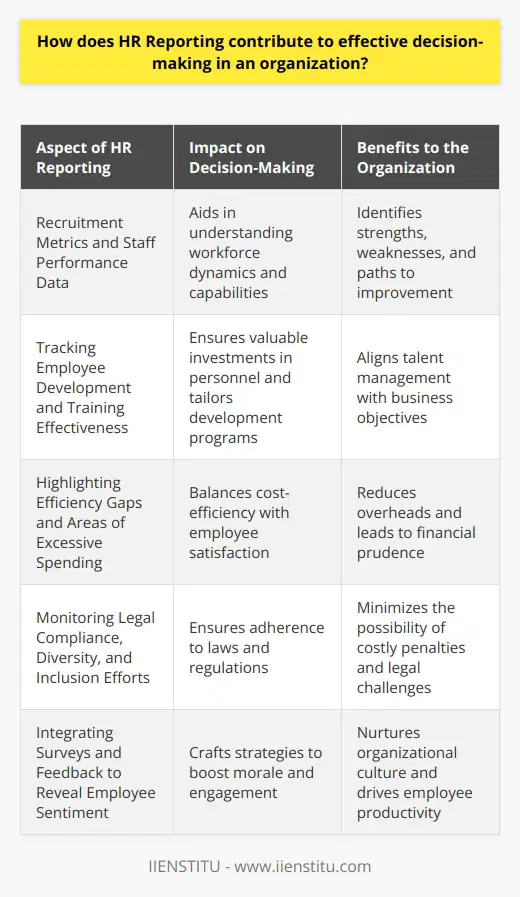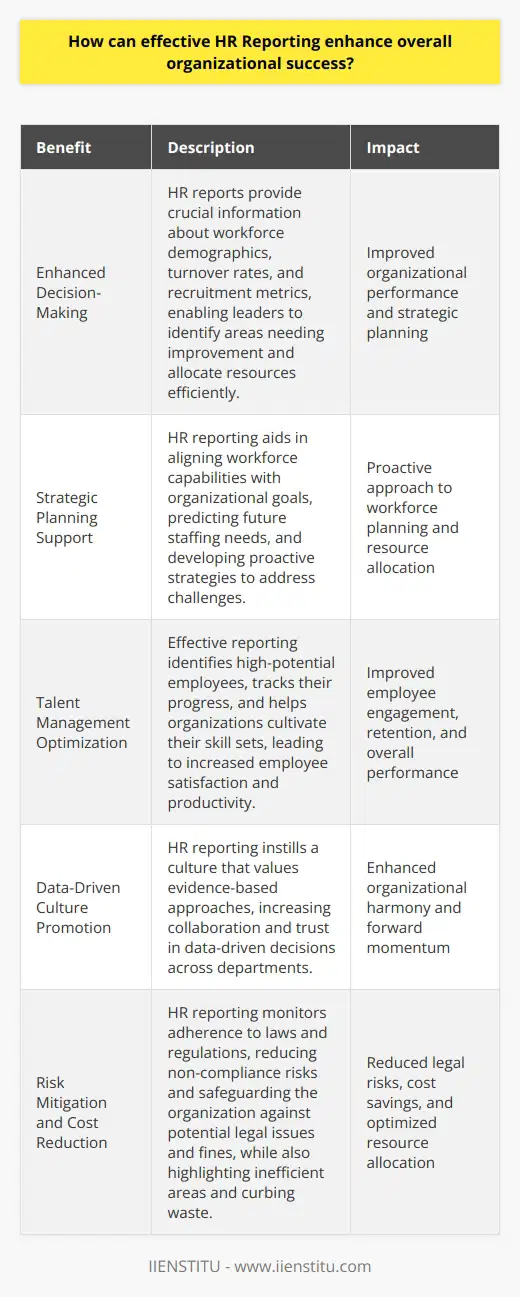
In the realm of human resources, HR reporting stands as a cornerstone for gauging the efficiency and effectiveness of personnel management within an organization. An evidence-based approach to human resource management necessitates robust reporting systems able to provide a clear snapshot of current HR activities and project future trends. HR reporting, when done rightly, becomes a strategic tool that supports decision-making and enhances organizational success.
In light of its importance, we shall navigate through the multi-faceted nature of HR reporting, its implementation challenges, and real-world applications, ensuring organizations can leverage data to maximize their most valuable asset—people.
Introduction to HR Reporting
HR reporting entails the systematic process of recording, analyzing, and presenting data related to human resources in an organization. This encompasses everything from staffing metrics to performance appraisals, financial expenditures on personnel, and compliance with labor regulations. The primary function of HR reporting is to transform raw data into intelligible information that aids the management in strategic planning and operational adjustments.
The significance of HR reporting is magnified in today's data-driven business environment where strategic decisions are increasingly underpinned by hard facts rather than intuition. Human resources play a pivotal role in the organizational tapestry, and the ability to quantify its contribution is essential. It enables organizations to monitor and measure the effectiveness of their people strategies and make informed decisions to enhance productivity and employee well-being.
HR reports take numerous forms, depending on the specific goals and requirements of the organization. Common types of reports include recruitment and turnover reports, training and development assessments, diversity reports, and compensation and benefits analyses. Each report serves a distinct purpose and offers insights into different facets of the HR function, enabling an encompassing view of the health and performance of the workforce.
How to Implement and Improve HR Reporting
In an era marked by rapid technological progress, the utilization of HR reporting software is no longer a luxury but a necessity for a detailed and efficient analysis of an organization’s workforce. Such software not only automates the collection of pertinent data but also assists in generating sophisticated reports that can drive strategic initiatives.
When aiming to establish or revamp HR reporting within an organization, the journey begins with the identification of core HR metrics that align with the business's strategic goals. Following this, a detailed plan to collect and manage relevant data must be set in place. An essential aspect of this step involves training HR personnel to use the technology effectively and understand the analytics generated.
During the implementation process, challenges may arise, including resistance to change, data inconsistencies, and technological setbacks. It's crucial to anticipate these challenges and prepare contingency plans. Successful implementation relies on a culture that values data-driven decision-making, a thoughtful integration of technology, and a continuous improvement mindset.
Fundamental Elements of Effective HR Reporting
To engender effective HR reporting, certain key elements must be standard in every report. These elements include clear objectives, accurate data, relevant metrics, and an accessible format that facilitates easy understanding. HR reports should aim not just to inform but to provide actionable insights that initiate positive change within the organization.
Actionable insights are borne from a deep analysis that goes beyond merely presenting statistics. HR professionals must delve into what the numbers mean in the context of the organization's goals and the external environment. It is a transformative practice transforming mere data into strategic knowledge.
The backbone of any HR report is data; therefore, the importance of data accuracy and data quality cannot be overstated. Erroneous data can lead to misguided strategies, which is why it's vital to establish rigorous data collection and validation processes. Ensuring the reliability of the data sets the stage for credible reporting and sound decision-making.
Real-life Examples of HR Reporting
Several organizations stand out for their exemplary use of HR reporting. These entities understand the strategic value of workforce analytics and have incorporated sophisticated HR reporting systems that have significantly contributed to their success.
Take for instance a multinational corporation that has streamlined its recruitment process by utilizing HR reporting to analyze the efficacy of different sourcing channels, thus optimizing their talent acquisition strategy. The insights garnered from turnover reports have also allowed the company to implement targeted retention programs, resulting in a marked reduction in employee attrition rates.
These organizations have overcome common hurdles by fostering a data-centric culture within their HR departments. They have invested in upskilling HR professionals in data literacy and have integrated cross-functional collaboration to ensure coherence and accuracy in their data reporting.
Key Metrics in HR Reporting
Understanding and tracking key metrics is integral to HR reporting. Different metrics such as the turnover rate, absenteeism, time to fill, and cost per hire provide valuable snapshots of HR's effectiveness. These metrics can highlight strengths, uncover areas for improvement, and guide HR strategies.
The turnover rate, for example, offers insights into the stability of the workforce, while measuring absenteeism can reveal underlying issues in employee engagement or job satisfaction. Time to fill is a critical metric for evaluating the efficiency of the recruitment process, and cost per hire helps in understanding the financial impact of talent acquisition.
Each of these metrics holds specific significance and sheds light on various aspects of HR's role within the organization. Collectively, they contribute to a comprehensive analysis that can steer organizational policies, improve employee morale, and ultimately impact the overall success of the business.
How to Leverage HR Metrics for Organizational Enhancement
By employing HR metrics within reports, organizations can undertake strategic planning and make informed decisions that foster growth and improvement. HR reporting provides the basis for understanding the dynamics of workforce management and allows for an objective assessment of HR practices and policies.
The use of HR reporting in decision-making can lead to improved employee performance and satisfaction as issues and opportunities become more apparent. Additionally, HR reporting can have a tangible effect on an organization’s bottom line. It helps in identifying cost-saving opportunities, optimizing employee productivity, and ensuring proper alignment of workforce capabilities with organizational objectives.
Future Trends in HR Reporting
The future of HR reporting is being shaped by the introduction of cutting-edge technologies such as artificial intelligence and big data. These advancements are expanding the horizons of HR reporting, providing more in-depth and predictive insights into workforce trends. Real-time analytics and personalized reports are becoming more prevalent, enabling HR professionals to respond swiftly and precisely to emerging issues and opportunities.
Predictive analytics is especially promising, offering a glimpse into the future of workforce dynamics. Organizations that embrace these future trends will have a competitive edge, being able to anticipate and prepare for potential challenges before they become critical.
The shift towards more personalised and dynamic HR reporting signifies a move towards a more strategic role for HR in the organization. As reporting tools become more sophisticated, the role of HR is evolving from administration-focused to strategy-oriented, with a significant emphasis on data and analytics.
HR reporting is more than just a clerical activity; it is a strategic tool that is vital to the smooth and efficient operation of organizations. Its role in enhancing decision-making processes, improving employee engagement, and driving organizational success cannot be overstated. The advent of new technologies and methodologies in HR reporting will continue to shape how organizations leverage this critical business function.
The continuous improvement and evolution of HR reporting practices are necessary to keep pace with the changing working environment and organizational needs. By embracing HR reporting and actively seeking to refine it, organizations can ensure they remain agile, informed, and prepared to meet the challenges of the modern business world. For those looking to deepen their expertise in the realm of HR analytics, engaging in an hr certificate course or exploring relevant online courses with certificates could be an invaluable step towards mastering the intricacies of HR reporting.
Frequently Asked Questions
How does HR Reporting contribute to effective decision-making in an organization?
HR Reporting and Effective Decision-Making
In any organization, decision-making serves as its backbone. It relies on data. Human Resources (HR) reporting offers a rich data source. It generates insights. These insights guide leaders. They inform strategic choices.
The Role of HR Reporting
HR reporting encapsulates vast data pools. It includes recruitment metrics and staff performance data. Turnover rates and training outcomes also feature. This information proves crucial. It aids in understanding workforce dynamics.
Leaders tap into these reports. They strategize based on workforce capabilities. They identify strengths and weaknesses. HR reporting illuminates paths to improvement.
Data-Driven Strategies
Data drives modern strategies. Organizations thrive on accurate, timely information. HR reports deliver this. They offer snapshots of organizational health. This information shapes strategic planning.
Leaders rely on reports to predict trends. They foresee recruitment needs. They also anticipate skill gaps. Such foresight is invaluable. It supports proactive rather than reactive strategies.
Improving Talent Management
Talent management benefits greatly. HR reporting tracks employee development. It captures training effectiveness. Such data ensures valuable investments in personnel.
Organizations understand their workforce better. They tailor development programs. They align talent management with business objectives. All thanks to HR reporting.
Cost Optimization
Cost savings stem from informed decisions. HR reporting highlights efficiency gaps. It pinpoints areas with excessive spending. Leaders use this information. They balance cost-efficiency with employee satisfaction.
Overheads reduce when decisions rely on solid data. HR reporting offers that. It leads to financial prudence. Investments in human capital become more targeted.
Enhanced Compliance
Compliance is non-negotiable. HR reports include legal compliance statuses. They track diversity and inclusion efforts. This aspect of HR reporting holds organizations accountable. It ensures adherence to laws and regulations.
Lapses in compliance entail risks. They can lead to costly penalties. Accurate HR reporting mitigates such risks. It minimizes the possibility of legal challenges.
Facilitating Culture and Engagement
Organizational culture shapes its success. Engagement drives employee productivity. HR reporting monitors these intangibles.
Surveys and feedback integrate into reports. They reveal employee sentiment. This information is powerful. Leaders craft strategies to boost morale and engagement.
HR reporting anchors informed decision-making. It provides a data-rich foundation. Leaders draw on this resource. They make decisions that align with their workforce's best interests.
Effective HR reporting transforms organizations. It optimizes talent management. It promotes cost savings. It upholds compliance. It even nurtures culture.
Every decision counts in business. HR reporting ensures they count for the better.

How can effective HR Reporting enhance overall organizational success?
Effective HR Reporting and Organizational Success
Effective HR reporting proves crucial in enhancing organizational success. It translates vast data into actionable insights. These insights guide leaders in making informed decisions. Organizations thus benefit from improved performance management and strategic planning.
Enhanced Decision-Making
HR reports provide leaders with vital information. This information concerns workforce demographics, turnover rates, and recruitment metrics. Leaders use these metrics to make critical decisions. They identify areas needing improvement. Also, they allocate resources more efficiently.
Strategic Planning Support
HR reporting aids in strategic planning. It aligns workforce capabilities with organizational goals. Data-analyzed trends predict future staffing needs. Leaders foresee challenges. They develop strategies proactively.
Talent Management Optimization
Effective reporting improves talent management. It identifies high-potential employees. It also assists in tracking their progress. Organizations can thus cultivate their skill sets. They engage and retain top talent. Employee satisfaction and productivity rise.
Data-Driven Culture Promotion
A culture that values data thrives on evidence-based approaches. HR reporting instills this culture. Employees across departments trust data-driven decisions. Collaboration increases. This harmonization propels the organization forward.
Risk Mitigation
Organizations face various compliance risks. HR reporting monitors adherence to laws and regulations. Non-compliance risks reduce. It thus safeguards the organization against potential legal issues and fines.
Cost Reduction
Resource optimization results from effective HR reporting. It highlights inefficient areas. Actions follow to curb waste. Cost savings result. Organizations allocate funds to more impactful investments.
Improved Communication
Reports facilitate clear communication. They provide a basis for dialogue among departments. Understanding increases. Misinterpretations decrease. Common goals become the focus.
Employee Development and Retention
HR reports uncover training needs. They reveal skill gaps. Targeted training programs emerge. Employees grow. They feel valued. Retention rates improve.
Competitive Advantage Gain
Finally, effective HR reporting offers a competitive advantage. It enables organizations to adapt quickly. They respond to industry changes with agility. They attract top talent. They meet market demands. Success ensues.
In summary, HR reporting directly contributes to organizational success. It enables precise decision-making. It supports strategic initiatives. It optimizes talent management. It fosters a data-driven culture. It reduces risks and costs. It clarifies communication. It aids in employee development. Organizations thus gain an edge in today's competitive landscape.

Are there any potential risks or challenges to be aware of when incorporating HR Reporting into an organization's strategic framework?
Understanding HR Reporting
HR reporting plays a crucial role in strategic planning. It helps to identify workforce trends and informs decision-making. Despite its benefits, we must consider the potential risks and challenges it poses.
Data Privacy and Security
One major concern involves data privacy and security. HR reports contain sensitive personal information. Unauthorized access to this data can lead to serious breaches. Companies must ensure robust security measures are in place.
- Implement strong data encryption
- Establish clear access controls
- Conduct regular security audits
Employees trust employers with their personal information. Misuse or leakage can damage this trust irrevocably.
Data Accuracy and Relevance
Data accuracy is another key challenge. Reports rely on precise, up-to-date information. Inaccurate data can lead to flawed decisions.
- Validate data sources
- Update information regularly
- Train staff on data entry and management
Ensuring relevance also demands attention. Managers need insights that align with strategic goals. Irrelevant data can cloud judgment and divert focus.
- Align reports with strategic objectives
- Filter out unnecessary information
- Customize reporting templates for relevance
Integration and Compatibility
Technology integration forms a third challenge. HR systems must work seamlessly with other business software. Trouble integrating can lead to fragmented data landscapes.
- Invest in compatible software solutions
- Prioritize integration during HR system selection
- Seek expert IT advice when necessary
Resistance to Change
We must also consider employee resistance. Transitioning to a data-driven approach requires a cultural shift. Resistance can impede the successful adoption of HR reporting.
- Communicate the benefits clearly
- Involve employees in the process
- Provide training and support
Legal Compliance and Ethical Considerations
Lastly, legal compliance and ethics warrant attention. HR reports must align with labor laws and ethical guidelines.
- Stay informed on relevant legislation
- Train HR staff on legal compliance
- Consult with legal experts as needed
Operationalizing these practices is critical. It ensures HR reporting supports organizational strategy effectively and responsibly.



